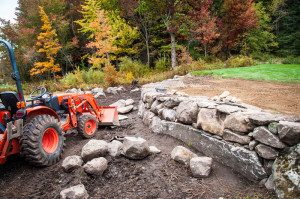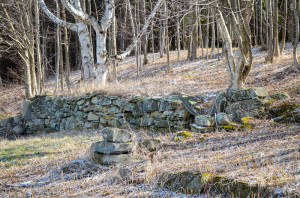A Ha-ha wall
This is my year of the ha-ha wall—a garden project I have wanted to implement for a some time now.
Looking out across this new wall, we enjoy the sight of Mount Moosalamoo, clearly visible some six miles away, and a great example of how borrowed scenery can become an integral part of our garden experience.
The age-old tradition of the ha-ha
The idea of a ha-ha wall has been around for at least a millennium, and is featured in French, Chinese and English landscapes. It is essentially a retaining wall, with a ditch on its lower side, constructed around the edge of the garden where the land slopes away towards a view beyond. With short grass extending right out to the top of the wall, it is virtually invisible to the people inside the garden, who can enjoy an unobstructed panorama of the countryside. At the same time large animals—either wild or domesticated—are kept at bay.
A landscape designer’s joke
Since a ha-ha wall created an invisible barrier (at least when seen from the higher side) it was considered as a sort of landscape designer’s joke, and named for the surprised reaction of people when they first encountered one. In France it is denoted Ah-Ah with the emphasis on the second syllable, but in England it is called Ha-Ha with the emphasis on the first syllable.
Either way the name conjures up a feeling of fun and surprise for the viewer.
The grand landscapes of 18th century England
The famous landscape designer, Lancelot ‘Capability’ Brown, liked to ‘improve’ the landscape for his clients–the landed gentry of eighteenth-century England. His ‘improvements’ revolved around creating grand, idealized pastoral vistas complete with serene ponds, groves of trees and rolling fields filled of grazing livestock. He was even known to have untidy elements—typically the cottages of local laborers—simply picked up and relocated to a new spot where they would be out of sight from the ‘big house on the hill’.
Capability Brown also made extensive use of ha-ha walls to create invisible ‘livestock enclosures‘ for his clients. Thus the cows and sheep, so desirably bucolic, could be enjoyed up close to the garden, all the while being restrained from trampling across the lawn and flowerbeds.
Our Vermont ha-ha—
–is a sixty-foot long retaining wall, but without a ditch, across which we enjoy our borrowed view of of the distant countryside.
.
.
.
An untidy starting point
Previously the edge of the lawn—where the land drops down about three feet–was kept in place by a jumble of large retaining rocks. Inevitably brambles and woody brush grew up through everything, creating a visual barrier and also making maintenance with a string-trimmer well-nigh impossible. And the meadow area below this rock jumble was strewn with still more large rocks, making Dick’s life very difficult as he came to do his annual sickle-bar mowing of our rough areas.
In just a few weeks with more rain than sun—
—and using only the rocks that littered the area, my friend Tammy Walsh transformed this unsightly mess into a beautiful curved three-foot high retaining wall.
Tammy is an expert stonemason and artist, and for more than twenty years she has specialized in building exquisite rock walls, stone steps and patios of all types for the discriminating gardener.
Together we decided the line of the new wall, starting at the large immovable rock in place at the south end.
Wall building involves several discrete steps:
- First Tammy positioned some massive rocks to form the base layer.
- Then she built up the body of the wall using a mix of large and medium sized rocks.
- After this she back-filled the space behind the wall with drainage stone which she covered with geo-fabric along the entire length of the wall. Geo-fabric (or geotextile) is like an industrial version of landscape cloth which permits water, but not soil, to pass through into the drainage stone layer below.
- Finally she added top-soil to bring the area behind the wall up to the grade of the lawn. She then finished the wall with a carefully laid capstone layer of flat rocks, creating a smooth interface with the lawn, and sowed grass seed which is now germinating nicely in the cool fall weather.
No moose barrier
One morning, as Tammy was topping off the new wall, she was more than a little surprised to discover the local moose had paid a visit the previous night. And furthermore— it was clear from the direction of the footprints—the animal had walked out of the woods to the east, across the lawn and DOWN over the new wall.
Since we knew our new ha-ha wall would never be needed to keep cows out of the garden, it lacks the traditional ditch on the lower side.
Even so I was more than a little chagrined to find it offered no barrier whatsoever to a moose wishing to LEAVE the garden. But I am also very relieved we did not put a ditch on the lower side. Had the moose stepped down over the wall and fallen into the ditch, he or she might have broken a leg—and that would have been very complicated!
Plants for the ha-ha
For our ha-ha wall to allow us to enjoy our ‘borrowed scenery’, it needs to be devoid of plantings on the upper side. Thus the lawn extends all the way to the top of the wall which is both smooth enough and strong enough to accommodate the lawn mower.
However the area below the wall will revert back to a naturalized meadow which Dick will mow each fall with his sickle-bar mower. But, with the rocks out of the way, he anticipates the job will be much easier than before.
At the same time, as part of my gift to the neighborhood, I would like to create an attractive setting for the hikers and bikers who come along our dirt road.
So this fall, as I am going through my garden clean-up ritual, I have been setting aside sturdy perennials that I anticipate will be able to compete successfully with meadow grasses that will grow below the wall.
So far I have planted two 10-foot stands, one with Black-eyed Susans (Rudbeckia fulgida) and the other with tall catmint (Nepeta subsesselis), and interspersed with both with clumps of daffodils. I plan on augmenting these with various ornamental grasses, most likely cultivars of switchgrass (Panicum virgatum)
A century old ha-ha
Tammy’s wall is not unlike another massive retaining wall on the east side of our garden. This one was built back in 1910 by the Hayes family who farmed this land for three generations. They made this huge structure, without modern equipment like a back-hoe, as one side of the foundation of the big barn that was set up against the slope.
Indeed, though it is only a few weeks old, Tammy’s wall is already starting to look like has been in place for a hundred years, and belongs to the landscape.
Which is just the way I want it.




